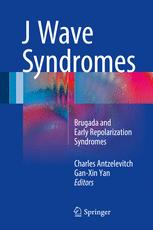J Wave Syndromes: Brugada and Early Repolarization Syndromes 2016
دانلود کتاب پزشکی سندرم های موج J: بروگادا و سندرم های رپلاریزاسیون اولیه
| نویسنده |
Charles Antzelevitch, Gan-Xin Yan |
|---|
| تعداد صفحهها |
327 |
|---|---|
| نوع فایل |
|
| حجم |
16 Mb |
| سال انتشار |
2016 |
89,000 تومان
سندرم های موج J امروزه یکی از داغ ترین موضوعات در قلب و عروق است. آریتمی های مرتبط با الگوی BrS یا رپلاریزاسیون اولیه (ER) در لیدهای ECG جانبی تحتانی یا تحتانی، از نظر مکانیکی به تشدید امواج جریان خارجی گذرا (ITO) مرتبط است. اگرچه سندرم BrS و ER (ERS) با توجه به اندازه و محل اولیه امواج J غیر طبیعی متفاوت است، تصور می شود که آنها طیف پیوسته ای از بیان فنوتیپی به نام سندرم های موج J را نشان می دهند. ERS به سه زیر گروه با شدیدترین نوع تقسیم می شود. نوع 3، الگوی ER سراسری را در بخیه های اولیه تحتانی، جانبی و راست ارائه می دهد. BrS با جهش در 19 ژن مختلف همراه است، در حالی که ERS با جهش در 7 ژن مختلف مرتبط است.
سردرگمی زیادی در مورد چگونگی تشخیص و درمان صحیح سندرم های موج J و همچنین در مورد مکانیسم های اساسی وجود دارد. نشان دادن موفقیت آمیز ابلیشن اپیکاردی BrS گزینه های درمانی جدیدی را برای مدیریت این سندرم باز کرده است که در حال حاضر جایگزین های درمانی برای آن بسیار محدود است، به ویژه در مورد طوفان های الکتریکی ناشی از VT/VF مکرر غیرقابل کنترل. این الگوی قطبش مجدد در اوایل 2-5٪ از جمعیت ایالات متحده مشاهده می شود. در حالی که واضح است که اکثریت قریب به اتفاق افرادی که الگوی ER را نشان می دهند در معرض خطر مرگ ناگهانی قلبی نیستند، چالش پیش رو شناسایی افرادی است که واقعاً در معرض خطر هستند و طراحی درمان های ایمن و مؤثر.
J wave syndromes are one of the hottest topics in cardiology today. Cardiac arrhythmias associated with Brugada syndrome (BrS) or an early repolarization (ER) pattern in the inferior or infero-lateral ECG leads are thought to be mechanistically linked to accentuation of transient outward current (Ito)-mediated J waves. Although BrS and ER syndrome (ERS) differ with respect to magnitude and lead location of abnormal J waves, they are thought to represent a continuous spectrum of phenotypic expression termed J wave syndromes. ERS is divided into three subtypes with the most severe, Type 3, displaying an ER pattern globally in the inferior, lateral and right precordial leads. BrS has been linked to mutations in 19 different genes, whereas ERS has been associated with mutations in 7 different genes.
There is a great deal of confusion as to how to properly diagnose and treat the J wave syndromes as well as confusion about the underlying mechanisms. The demonstration of successful epicardial ablation of BrS has provided new therapeutic options for the management of this syndrome for which treatment alternatives are currently very limited, particularly in the case of electrical storms caused by otherwise uncontrollable recurrent VT/VF. An early repolarization pattern is observed in 2-5% of the US population. While it is clear that the vast majority of individuals exhibiting an ER pattern are not at risk for sudden cardiac death, the challenge moving forward is to identify those individuals who truly are at risk and to design safe and effective treatments.




